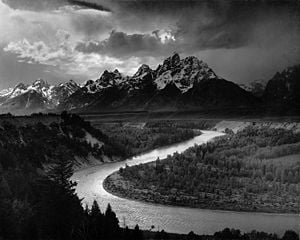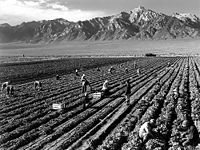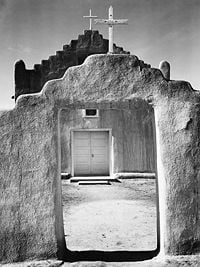Ansel Adams
Ansel Easton Adams (February 20,1902 – April 22, 1984) was an American photographer born in San Francisco.
Famous for his black & white landscape photographs of the national parks (Yosemite National Park among others), and as an author of numerous books about photography, including his trilogy of technical instruction manuals (The Camera, The Negative and The Print). He co-founded the photographic association Group f/64 along with other masters like Edward Weston, Willard Van Dyke, Imogen Cunningham and others.
He invented the zone system, a technique which allows photographers to translate the light they see into specific densities on negatives and paper, thus giving them better control over finished photographs. Adams also pioneered the idea of visualization (which he often called 'previsualization', though he later acknowledged that term to be a redundancy) of the finished print based upon the measured light values in the scene being photographed.
His use of the extremes of contrast, left few areas of the grey. This is seen as an extreme position in other fields but in the world of Art it shows a great beauty. People respond to this dichotmy of the depths of light and dark as something that can be seen within each and everyone of us. Also the duality of all that exists in nature is pointed up in this technique. We feel that he knows his subjects intimately although black and white is merely allegory or symbolic, as it does not exist in the real world. He is using two dimensionas to show us an eternal nature that we can all respond to, in dramatic form. This is also seen in his passion for conservation and compassion for the interned Japanese.
Life
Ansel Adams was born in San Francisco, California in an upper-class family. When he was 4, he was tossed face-first into a garden wall in an aftershock from the 1906 San Francisco earthquake, breaking his nose. His nose was never repaired and appeared crooked for his entire life.
He became interested in photography when his Aunt Mary gave him a copy of "In the Heart of the Sierras" [1] while he was sick as a child. The photographs in the book by George Fiske piqued his interest enough to persuade his parents to vacation in Yosemite National Park in 1916, where he was given a camera as a gift.
Adams disliked the uniformity of the education system and left school in 1915 to educate himself. He originally trained himself as a pianist, but Yosemite and the camera diverted his interest toward photography. He later met his future wife, Virginia Best, in Yosemite. Adams long alternated between a career as a concert pianist and one as a photographer.
At age 17 Adams joined the Sierra Club, a group dedicated to preserving the natural world's wonders and resources. He remained a member throughout his lifetime and served as a director, as did his wife, Virginia. Adams was an avid mountaineer in his youth and participated in the club's annual "high trips", and was later responsible for several first ascents in the Sierra Nevada. It was at Half Dome in 1927 that he first found that he could make photographs that were, in his own words, "...an austere and blazing poetry of the real". Adams became an environmentalist, and his photographs are a record of what many of these national parks were like before human intervention and travel. His work has promoted many of the goals of the Sierra Club and brought environmental issues to light.
Photographs in Adams' limited edition book, Sierra Nevada: The John Muir Trail, along with his testimony, are credited with helping secure the designation of Sequoia and Kings Canyon as national parks in 1940.
During World War Two Adams worked on creating epic photographic murals for the Department of the Interior. Adams was distressed by the Japanese American Internment that occurred after the Pearl Harbor attack. He was given permission to visit the Manzanar War Relocation Center in the Owens Valley, at the foot of Mount Williamson. The resulting photo-essay first appeared in a Museum of Modern Art exhibit, and later was published as Born Free and Equal: Photographs of the loyal Japanese-Americans at Manzanar Relocation Center, Inyo County, California.
In 1952 Adams was one of the founders of Aperture.
Adams was the recipient of three Guggenheim fellowships during his career. He was elected in 1966 a Fellow of the American Academy of Arts and Sciences. In 1980 Jimmy Carter awarded him the Presidential Medal of Freedom, the nation's highest civilian honor.
Publishing rights for the Adams' photographs are handled by the trustees of The Ansel Adams Publishing Rights Trust.
The Minarets Wilderness in the Inyo National Forest was renamed the Ansel Adams Wilderness in 1984 in his honor. Mount Ansel Adams, a 11,760' peak in the Sierra Nevada, was named for him in 1985.
Works
Notable photographs
- Monolith, The Face of Half Dome, 1927.
- Rose and Driftwood, 1932.
- Clearing Winter Storm, 1940.
- Moonrise over Hernandez, New Mexico, 1941.
- Ice on Ellery Lake, Sierra Nevada, 1941.
- Georgia O'Keeffe and Orville Cox at Canyon de Chelly
- Aspens, New Mexico, 1958.
Photographic books
- America's Wilderness, 1997. ISBN 1561387444
- California, 1997. ISBN 0821223690
- Yosemite, 1995. ISBN 0821221965
- The National Park Photographs, 1995. ISBN 0896600564
- Photographs of the Southwest, 1994. ISBN 0821206990
- Ansel Adams: In Color, 1993. ISBN 0821219804
- Our National Parks, 1992.
- Ansel Adams: Classic Images, 1986. ISBN 0821216295
- These We Inherit: The Parklands of America, with Nancy Newhall, 1962.
- This is the American Earth, with Nancy Newhall, 1960. ISBN 0821221825
- Born Free and Equal, 1944. Spotted Dog Press
Technical books
- The Camera, 1995. ISBN 0821221841
- The Negative, 1995. ISBN 0821221868
- The Print, 1995. ISBN 0821221876
- Examples: The Making of 40 Photographs ISBN 082121750X
See also
- Charles Hitchcock Adams, Ansel Adams' father, an amateur astronomer
External links
- Ansel Adams (1902–1984)
- Transcript of the Ric Burns feature documentary Ansel Adams (2002)
- Ansel Adams Gallery
Credits
New World Encyclopedia writers and editors rewrote and completed the Wikipedia article in accordance with New World Encyclopedia standards. This article abides by terms of the Creative Commons CC-by-sa 3.0 License (CC-by-sa), which may be used and disseminated with proper attribution. Credit is due under the terms of this license that can reference both the New World Encyclopedia contributors and the selfless volunteer contributors of the Wikimedia Foundation. To cite this article click here for a list of acceptable citing formats.The history of earlier contributions by wikipedians is accessible to researchers here:
The history of this article since it was imported to New World Encyclopedia:
Note: Some restrictions may apply to use of individual images which are separately licensed.




